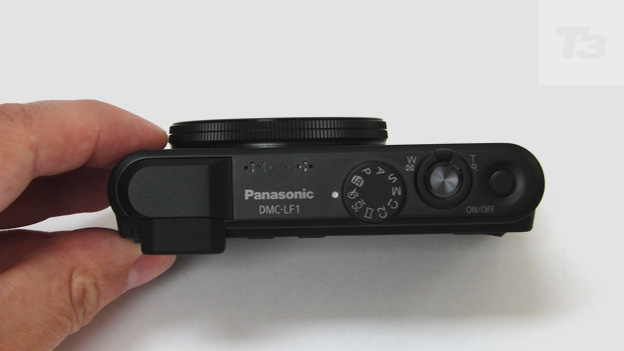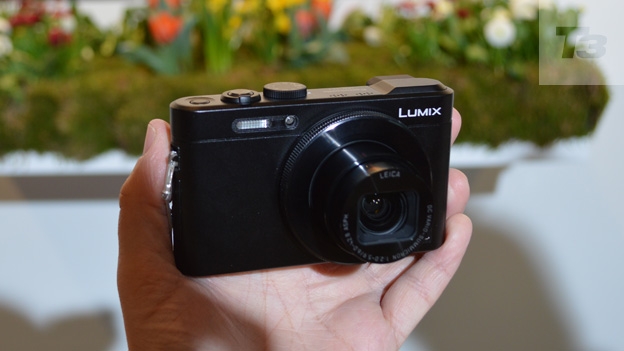Panasonic LF1 review
The Panasonic Lumix LF1 is a premium compact with wireless connectivity


-
+
Solid-feel build
-
+
Electronic viewfinder
-
+
Raw files can be shot
-
-
It's pricier than rivals
-
-
Pixel fringing
Why you can trust T3









The Panasonic LF1 is a stylish 12-megapixel compact alternative to the LX7 incorporating a viewfinder, Wi-Fi and NFC
To outperform the smartphone, pocket digital compacts now come festooned with bells and whistles that provide the sort of manual, hands-on photographic control that at one time you'd only get via a digital SLR, along with creative image-enhancing options familiar from phone apps.
The relatively slender Panasonic Lumix LF1 measures just 27.9mm deep and comes with a suggested price tag of £375, a bright f/2.0 maximum aperture lens (an improvement on the usual f/2.8) aiding low light shooting without flash and achieving those shallow focus effects we love getting with our DSLRs, plus wireless communication with either phone or desktop PC via Wi-Fi and NFC.
Add to this a respectable 7.1x optical zoom with manually operated lens control ring offering a 35mm equivalent focal range of a wide angle 28-200mm, and Full HD 1,920 x 1,080 pixels video and it would seem that if you're looking for a fixed lens pocket compact that gives a bit more control than your average point and shoot - plus is a little cheaper and more up-to-date tech-wise than the 2012's Panasonic LX7 flagship compact - the LF1 could be a good bet.
Headline resolution is 12.1 megapixels from a 1/1.7-inch CMOS sensor, so one larger in size than the 1/2.3-inch CCD found in 90% of pocket snapshots, even if the maximum resolution reads as sensibly modest.
Solid rivals in this price range include the retro-styled Fujifilm XF1, a cheaper alternative to its own Fujifilm X20 for around £319, the Olympus XZ-10, baby brother to its Olympus XZ-2, at £349.99, plus the Sony Cyber-shot HX50.
While the Fuji and Olympus offer a tad brighter f/1.8 lens than the Panasonic, the HX50 ups the zoom ante to an incredible 30x times and squeezes in 20.3 megapixels for £350, making the LF1 appear rather out-gunned if we were concerned with numbers alone.
However the LF1's saving grace comes in the shape of a small electronic viewfinder positioned at eye level top left of the camera back, something of a rarity in present company and a feature that will appeal to enthusiasts.
Panasonic Lumix LF1: Controls
With a serious-looking matt black finish and narrow body, the LF1 looks to appeal to purveyors of cool as much as photo enthusiasts, who will love the stiff-action lens control ring, shooting mode dial with full auto, manual and custom settings, plus small eye-level electronic viewfinder, offering an alternative to the larger LCD below.
The LF1 is one of the smallest cameras of its type to feature an EVF, so it comes as a rather unexpected bonus for those who prefer shooting with the camera to their face rather than held out from the body at shoulder height.
Though there is a regular forefinger-operated lever surrounding the shutter release on the top plate for controlling the zoom, this can also be achieved via the lens ring if desired, which further provides the options to manually tweak aperture and shutter speed settings.
On the downside, what's obviously lacking from the camera is anything approaching a handgrip, with the smooth faceplate hardly helping. Yes a hand strap is provided and there's a place to stick your thumb at the back too, but we have sacrificed this aspect of the handling for the overall smaller, more streamlined proportions.
While compact snapshot users won't find anything daunting here at first glance, the spec and level of control provided means that the LF1 adds up to a camera that we felt we could do a bit more than just point and shoot with.
That said, you can indeed just do exactly that if wanted - as scene and subject recognising and parameter adjusting intelligent Auto Mode (iA) is one of the most recognisable settings on the small five-pence piece sized mode dial.
Panasonic Lumix LF1: Screen
As we've noted, there are two screens offered by the LF1. Whereas most compacts of this size rely purely on a backplate LCD for stills and video composition and review, here there's the alternative of a 200,000-dot resolution, 0.2-inch electronic viewfinder which provides dioptric correction, just like a bridge camera or DSLR.
Get all the latest news, reviews, deals and buying guides on gorgeous tech, home and active products from the T3 experts
And, as it's electronic rather than optical, there's the ability to review shots this way too, though the smaller screen size naturally makes it much harder to check for critical focus and detail, and it pretty quickly starts to tire the eyes.
Itís a shame that this doesn't come with an eye sensor to automatically switch the EVF on or off, which would have made for a more seamless operation; instead it needs to be activated via a LVF button alongside. Still it's undoubtedly a cool touch.
The larger main screen offers the standard 3 inches, yet with a high 920,000 dot resolution, a spec that until relatively recently was only seen on semi-pro DSLRs, but now appears commonplace on high-end compacts and system cameras too.
The image relayed is bright and clear, though all the Panasonic icons ranged around it do become slightly distracting and in sunlight it suffers from the need to squint at it.
Panasonic Lumix LF1: Battery
The LF1 incorporates the usual lithium ion rechargeable battery, though as is becoming increasingly common, we don't get a separate charger out of the box, just a mains plug with a slot for a USB lead. This means that the cell is charged within the camera and so the LF1 is out of action when this is happening.
Battery life from a full charge is good for a suggested 250 shots, which is average for this class of camera without being especially remarkable.
Panasonic Lumix LF1: Picture quality
While in common with 99% of all Panasonic cameras the LF1 gives a reliably consistent performance from shot to shot with nicely saturated colours, familiar compact camera bugbears such as pixel fringing inevitably rear their head. There is, however, the boon of being able to shoot Raw as well as JPEG for trickier exposures and compare the results, with the Raw generally maintaining more of the detail the JPEG loses.
As is usual with Panasonic, LF1 users get a choice of shooting High Def video in either MPEG4 or AVCHD formats, with a dedicated record button located top right of the backplate where it falls beneath the thumb. Stereo sound recording is offered too, which is a cut above, as is the fact that the full extent of the zoom can be used when recording video, as can the creative image modes for adding extra visual pep.
Stills can also be extensively retouched after the shot is taken, making for a versatile camera the operation of which falls somewhere between what one would expect from any pocket camera and that of an entry-level CSC or DSLR, save for the fact that its f/2 maximum aperture lens cannot be swapped.
Panasonic Lumix LF1: Verdict
While it's hard to find a great deal wrong with the 12 megapixel LF1, competition is increasingly fierce in the expanding premium compact sector; from the alternatives suggested in our intro, but also from Sony's RX100, probably still the best quality and value premium snapshot out there for just a little bit more.
So why would we choose the LF1? Well, the unexpected inclusion of a viewfinder undoubtedly sets it apart from the pack for photo traditionalists, while it's one of the first ever compacts to come with NFC connectivity and the ability to shoot Raw alongside JPEG within such a small form factor is another bonus.
Panasonic Lumix LF1 release date: Out now
Panasonic Lumix LF1 price: £374.99

Gavin Stoker has been writing about photography and technology for the past 20 years. He currently edits the trade magazine British Photographic Industry News - BPI News for short - which is a member of TIPA, the international Technical Imaging Press Association.